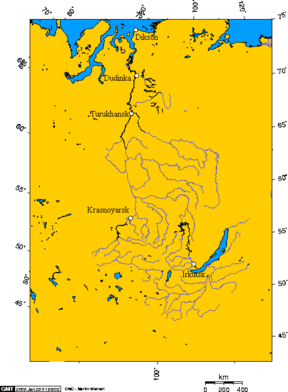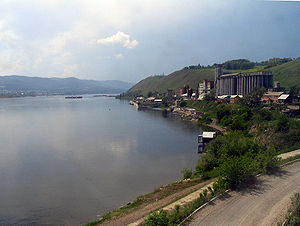
Yenisei River
Did you know...
This Schools selection was originally chosen by SOS Children for schools in the developing world without internet access. It is available as a intranet download. To compare sponsorship charities this is the best sponsorship link.
| Yenisei River | |
|---|---|
 The Yenisei basin, including Lake Baikal |
|
| Origin | Tuva (Russia), Darkhad Valley (Mongolia) |
| Mouth | Arctic Ocean |
| Basin countries | Russia, Mongolia |
| Length | 5,539 km (3,445 mi) |
| Avg. discharge | 19,600 m³/s (692,272 ft³/s) |
| Basin area | 2,580,000 km² (996,138 mi²) |
Yenisey (Russian: Енисе́й) is the greatest river system flowing to the Arctic Ocean, and at 5,539 km (3,445 mi) is the fifth longest river in the world. Rising in Mongolia, it follows a northerly course to the Yenisei Gulf in the Kara Sea, draining a large part of central Siberia, the longest stream following the Yenisei-Angara-Selenga-Ider.
The upper reaches, subject to rapids and flooding, pass through sparsely populated areas. The middle section is controlled by a series of massive hydroelectric dams fuelling significant Russian primary industry. Partly built by gulag labor in Soviet times, industrial contamination remains a serious problem in an area hard to police. Moving on through sparsely-populated taiga, the Yenisei swells with numerous tributaries and finally reaches the Kara Sea in desolate tundra where it is icebound for more than half the year.
Upper Yenisey
The Yenisey rises in two major headstreams: the Bolshoi (greater) Yenisey also known as the Bii-Khem (Бий-Хем) rises in the Tuva region on the S flank of the Eastern Sayan Mountains and north of the Tannu-Ola Mountains at 52°20′N 97°30′E; the Malyy (lesser) Yenisey· also known as the Kaa-Khem (Каа-Хем) rises in the Darkhad ( rift) valley in Mongolia. Recent research has shown that the narrow exit to the Darkhad Valley has regularly been blocked by ice producing a lake as large as neighbouring Lake Khövsgöl. When the glaciers retreated (the last time 9300 years BP) as much as 500 km³ of water would have escaped, possibly catastrophically.
Lake Baikal headwater
The 320 km (partly navigable) Upper Angara River feeds into the northern end of Lake Baikal from the Buryat Republic but the largest inflow is from the Selenga which forms a delta on the south-eastern side. The longest tributaries rise on the eastern slopes of central Mongolia's Khangai Mountains. Another tributary, the Tuul passes through the Mongolian capital, Ulan Bator while the Egiin Gol drains Lake Khövsgöl.
Angara River
The Angara River (Ангара́) river drains Lake Baikal and runs 1840 km from the regional capital Irkutsk to converge with the Yenisei at Strelka ( 58.101° N 92.998° E). It is dammed in four places to power local industry. The 44m dam at Irkutsk produces 650 MW. Bratsk lies 500 km downstream, where the 124 m dam built in the 1960s produces 4500 MW. The resultant reservoir is nicknamed Dragon Lake because of its outline. The tributary Oka and Iya rivers, which rise on the north slopes of the Eastern Sayan Mountains, form the 'jaws' and 400 km of the Angara form the 'tail'. There are newer dams almost as large at Ust-Ilimsk 250 km downstream (also damming the tributary Ilim river) and Boguchany a further 400 km downstream (not operational). Further dams are planned but the environmental consequences of completely taming the Angara are leading to protests which may prevent funding.
Angarsk, the centre of the expanding Eastern Siberian oil industry and site of a huge Yukos-owned refinery, lies 50 km downstream of Irkutsk. A major pipeline takes oil west, and a new one is being built to carry oil east for supply to Japan from the Sea of Japan port of Nakhodka. The exact potential of Eastern Siberia is unknown, but two new major fields are the Kovyktinskoye field near Zhigalovo 200 km north of Irkutsk and the extremely remote Verkhnechonskoye field 500 km north of Irkutsk on the Central Siberian Plateau.
Lower Yenisei
The Great Kaz joins the Yenisei 300 km downstream from Strelka. It is noteworthy for its connection to the Ob via Ob-Yenisei canal and Ket River. The river starts to widen, its bed being littered with islands as numerous rivers augment its flow, in particular 1800 km Stony (Podkamennaya) Tunguska, and the 3000 km Lower (Nizhnyaya) Tunguska at Turukhansk draining the desolate central Siberian Plateau from the east. The remote Tunguska (Тунгуска) region is most famous for the 1908 meteorite impact, but is now being explored for oil. Beyond Turukhansk, the river enters tundra territory.
The river is icebound for more than half the year, and if unchecked ice could dam the river causing major flooding. Explosives are used to keep the water flowing. The final town is Dudinka which is connected to Krasnoyarsk by regular passenger boat. The river widens to a 50 km estuary, the Yenisei Gulf, for its final 250 km and the shipping lanes are kept open by icebreaker.
During the ice age, the route to the Arctic was blocked by ice. Though the exact details are unclear, the Yenisei is believed to have flowed into a huge lake filling much of western Siberia, eventually flowing into the Black Sea. (See West Siberian Glacial Lake of the early Weichselian Glaciation)
The first team to navigate the Yenisey's entire length, including its violent upper tributary in Mongolia, was an Australian-Canadian effort completed in September 2001. Ben Kozel, Tim Cope, Colin Angus and Remy Quinter were on this team. Both Kozel and Angus wrote books detailing this expedition, and a documentary was produced for National Geographic Television.
History
Ancient nomadic tribes such as the Ket people and the Yugh people lived along its banks. The Ket, numbering about 1000, are the only survivors today of those who originally lived throughout central southern Siberia near the river banks. Their extinct relatives included the Kotts, Assans, Arins, Baikots, and Pumpokols who lived further upriver to the south. The modern Ket lived in the eastern middle areas of the river before being assimilated politically into Russia during the 17th through 19th centuries.

